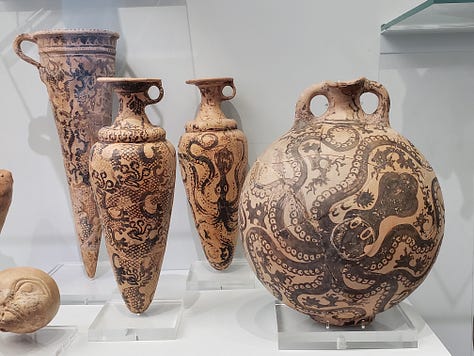
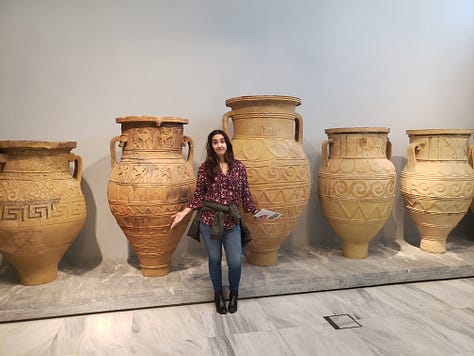
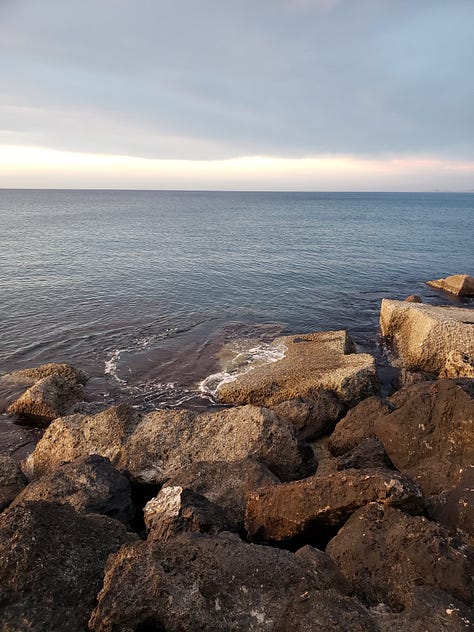
When I think back to my first visit to Greece, three things come to mind every single time:
Octopi, octopi everywhere
Drinking ouzo with the elderly owner of a local restaurant on Crete
And looking out onto Homer’s “Wine Dark Sea”
Besides our glorious visit to the Parthenon :) these three things were the most meaningful and memorable from that nearly-canceled trip. Truly, it happened against all odds, as we were then on the cusp of a COVID lockdown in Rome in March 2020. As part of our program for an Ancient Mural Painting class as graduate students, we had to visit Greece to see these works in person. However, the virus was still recent news then, and my university was in a strange limbo, not knowing yet what it would do.
In a matter of days, we were told that all class trips were canceled until further notice. However, soon after, we were informed that students could still travel if they wanted, but professors were not allowed to tag along or sponsor/openly approve of/ suggest any trips. So, with a fully booked hotel and itinerary, my roommate/close friend and I packed up and headed to Greece anyway. We could see the looming lockdown in the near future and didn’t want to miss an opportunity we would regret later. As long as we were permitted to travel and move around, we would do so!
There’s a reason why the allegory of Fortune or Opportunity is an old man with only one lock of hair in the front, but in the back, he's bald. If you don’t “seize him by the locks,” you will never again get the chance when he turns his head and moves on. Well, this was us seizing Opportunity, and a week later when we returned to Rome, we were so relieved we did.
We followed the class’ itinerary as best as possible which meant we had three legs: Crete → Santorini → Athens which also means that this post will be a three-parter :) — andiamo!
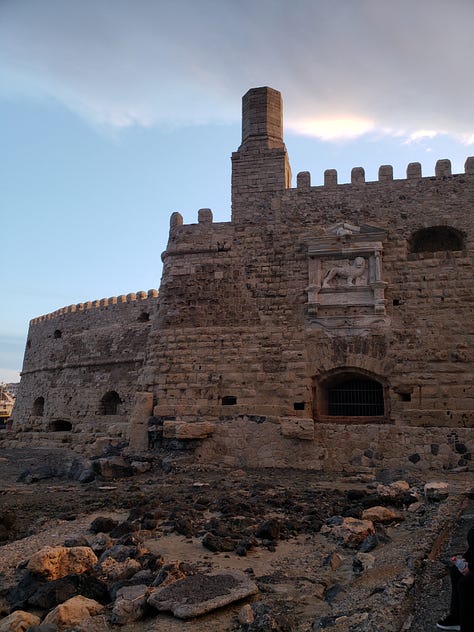
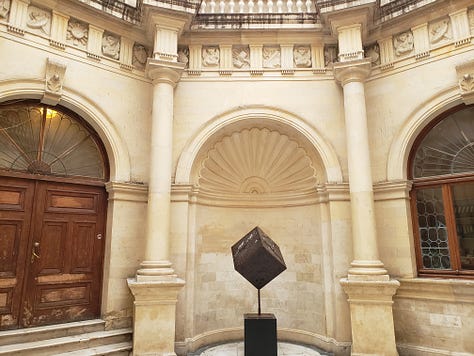
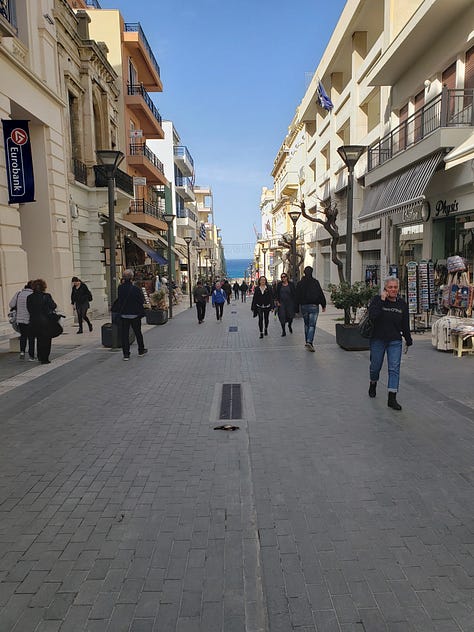
Part I: Heraklion, Crete
The first stop on our class itinerary was Heraklion, the capital of the island of Crete. While Santorini and Mykonos take center stage (not entirely without reason), Crete is an underrated gem. This small, beautiful island was the epicenter for some of the most notable stories in Greek Mythology: it was the home of King Minos, his daughter Princess Ariadne, and the fearsome Minotaur, forever prowling the underground labyrinth. And, it was the birthplace and home of Zeus, king of the gods, who was secretly raised by nymphs to hide him from his father, Kronos.
When we arrived, we checked into our hotel. The Hotel Lena is a locally run, cozy place to stay if you’re on a budget – which we were. For 30 euros a night, it was a great deal! The beds were comfy, the room was clean, free wifi, and the private shower gave us no trouble. Plus, it’s within walking distance of all the major attractions in the area.
Ouzo
After checking in and getting settled, we set off to find some food. I can’t remember the name of the restaurant but I do remember the huge public fountain with lions! Formally known as The Morosini Fountain, this gorgeous Venetian Medieval fountain with four carved lions dominates the center of this buzzing piazza – filled with music, talking, laughing, and just shenanigans in general. The night air was crisp and pleasant.
It is also the reason why the square is commonly referred to as “Lions Square,” versus its official name: Eleftheriou Venizelou Square, named after a prominent Cretan statesman.
What’s so nice about Crete is that the tourists and the locals kind of blended together, so dodging tourist traps wasn’t high on our list; we were hungry enough that we didn’t care! The restaurant we picked was slightly to the right of the fountain, hidden by some trees. We sat outside and had moussaka (cause you’ve got to at least once) with grilled octopus (one of my favorite dishes) with some grilled vegetables and fries.
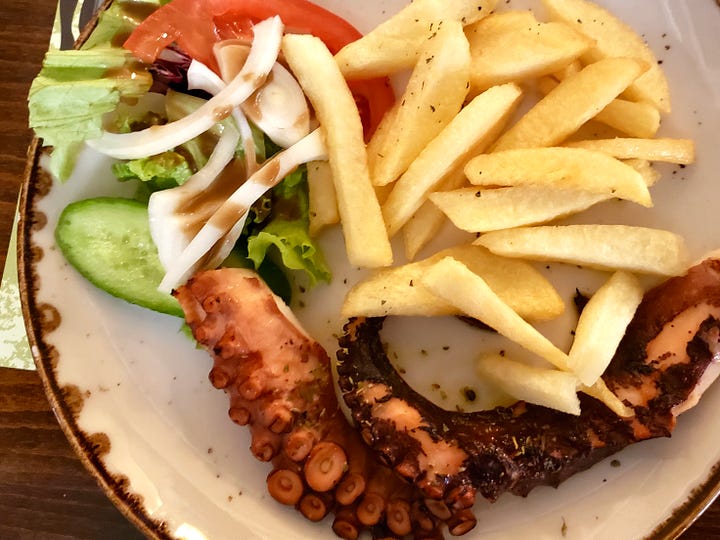
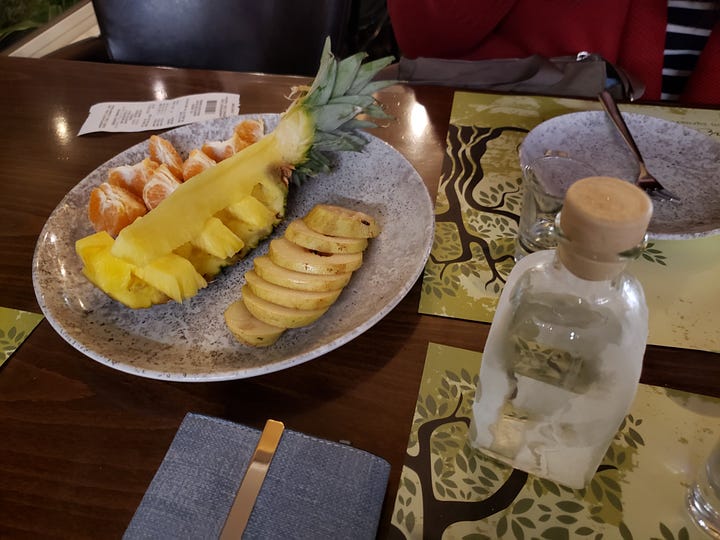
Eventually, the owner, an elderly man who was very excited to see us (we were in the off-season and tourism was on the low side) as a “token of appreciation,” as he said, brought a HUGE tray of fruit drizzled with honey and a bottle of Ouzo.
He passed around small glasses and said “We drink together, join me for a drink.” It was our first time trying ouzo, so you can imagine our faces when it went down! Ouzo has a strong anise component, so it tasted like black licorice, sweet yet very potent! More than anything I was so happy to have experienced the quintessential xenia, an ancient Greek concept of hospitality that is often translated as “guest-friendship.”
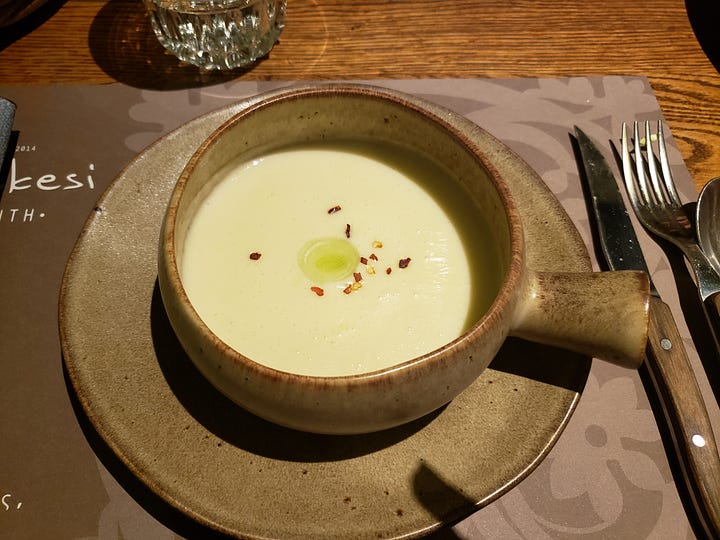
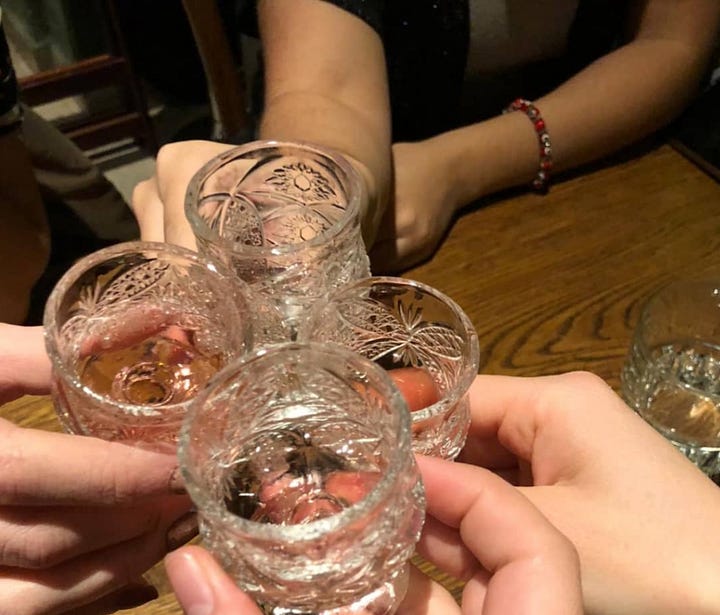
It is a relationship based on hospitality and goodwill and forms an important theme in Homer’s The Iliad and The Odyssey. Ironically, one of Zeus’ most important roles was the protector of hospitality, ensuring that xenia was being upheld as a moral imperative. Thus, one of his many epithets was Zeus Xenios, “Zeus the protector of strangers.” We kept going until the bottle was finished and the dessert consumed. It’s safe to say this night became one of my favorite memories associated with this trip.
If you’re in Heraklion and feeling particularly fancy, you can’t wrong with Peskesi, a restaurant in the heart of the city dedicated to serving authentic Cretan cuisine. Whether it was truly authentic I can’t say, what I can say is that the food was delicious, the place was gorgeous, and the service was excellent! I wasn’t feeling my best at that time (this was a day or two later) and their potato and leek soup was just what the doctor ordered. As a way of thanking us for our business, the waiter brought over tiny glasses of their local rose petal wine! Rose as a flavor is hit or miss. I personally love it, but the others thought it tasted like dish soap – which is valid. I blame potpourri.
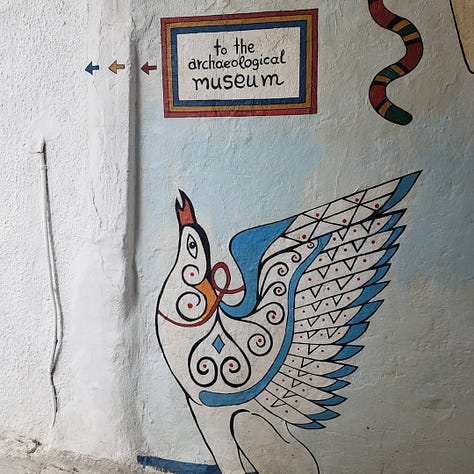
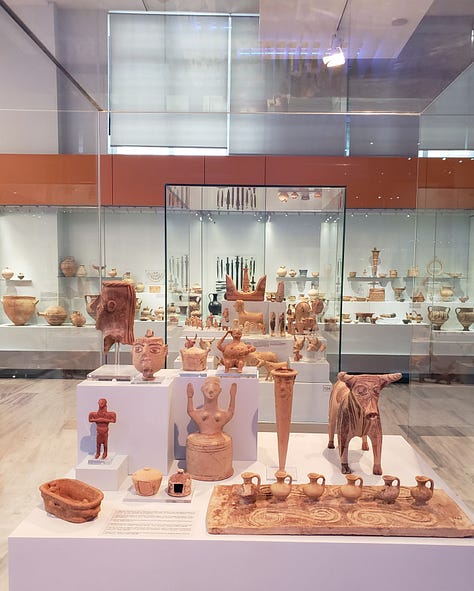

Octopi
Museum day! So after waking up earlier than usual, hunting down some coffee, and sharing breakfast with a cute stray (we named him Cerberus, cause why not), we made our way to The Heraklion Archaeological Museum, our first major destination in Crete! One of the largest museums in Greece, it houses one of the most important and complete collections of artifacts of the Minoan civilization of Crete (Bronze Age civilization, c. 3000 – 1100 BCE).
We arrived to find it open and blissfully empty and all to ourselves. Among the many notable items in the collection, the museum is home to the famous Phaistos disc, the fresco of the “Leaping Bull,” the “Snake Goddess” figurine, and the lovely “Blue Ladies” fresco, among many other incredible finds! This includes an entire section dedicated to Minoan jewelry. Created from precious metals and gemstones, Bronze Age metalworking techniques and designs set the stage for later jewelry production.

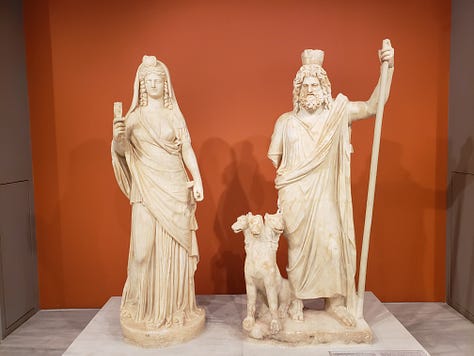
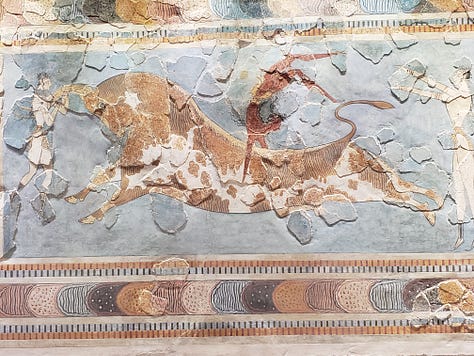
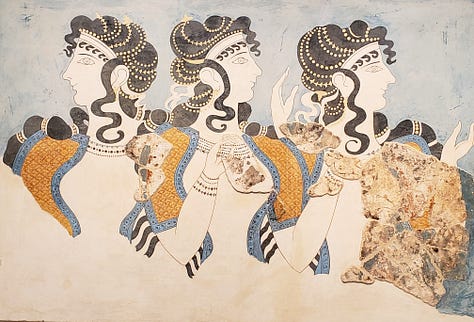
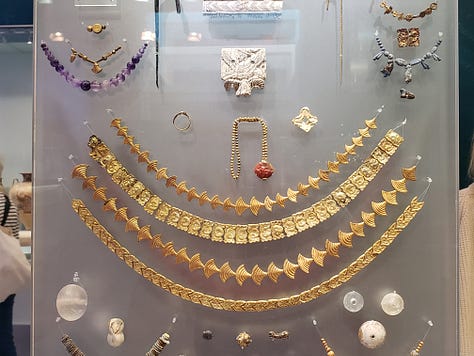
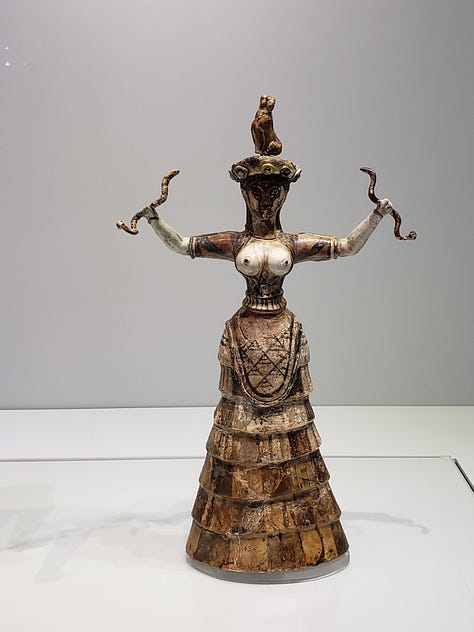
And, yes we were complete nerds about it. Having seen these artworks on a screen in class not too long ago, we were ecstatic to see them in person! One particular sculpture was a complete surprise as I didn’t know the museum had it in its collections: the sculpture of Hades and Persephone in the guise of Isis and Serapis. The syncretism (or combination of) gods from different pantheons was common in the ancient world: “The cult of the Egyptian gods is attested at many sites of the ancient Greek world and became quite popular during the Hellenistic period.”1 The same can be said in the Roman world as Isis had many temples in shrines in both Rome and Pompeii.
There is also a lot (A LOT) of pottery. Besides the enormous life-size Pithoi, large ceramic containers used to store olive oil and wine among other things, I noticed that we were surrounded by Minoan vases painted with dozens and dozens of octopi.
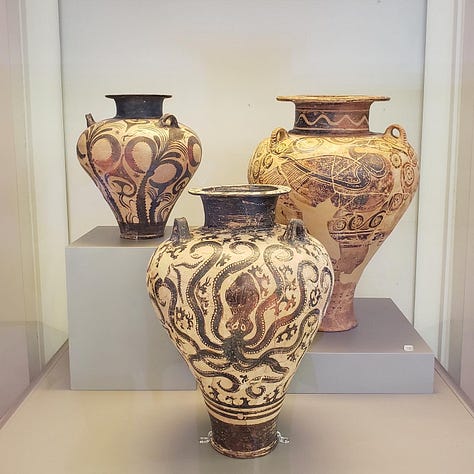
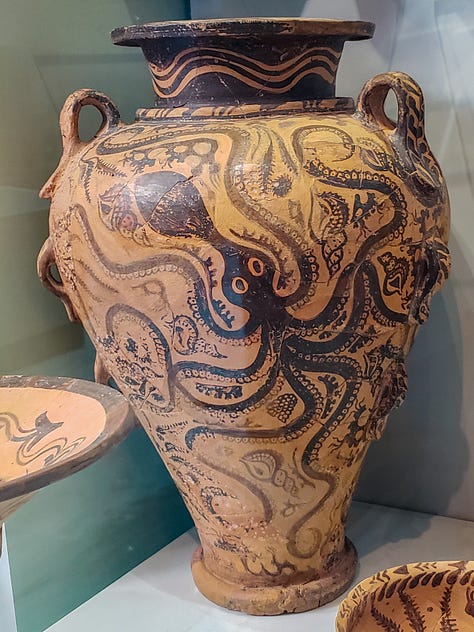
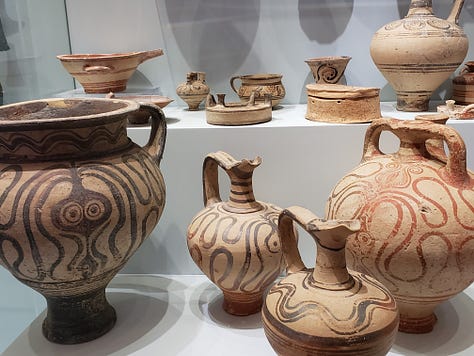
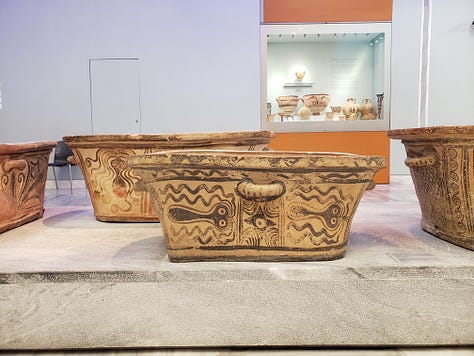
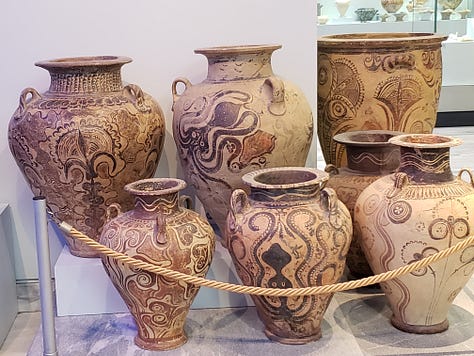
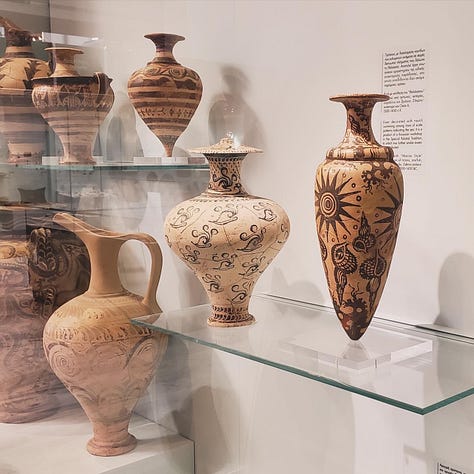
Side note – It’s incredibly frustrating to me that the technically correct plural for “octopus” is “octopuses” and not octopi which, to me, sounds better. The reason for this 200-year-old debate concerns the words’ Greek origin and the way words are adopted into the English language. Since octopus is a Greek word that is being adopted into English, it needs an English ending: “octopuses.” A Greek ending would make it octopods if you’re curious. Frankly, the Grammar Police can pry octopi from my cold dead hands — along with the Oxford comma.
Anyway, these little eight-legged critters were everywhere! On wall paintings, pottery, bathtubs, and even jewelry. The so-called Minoan ‘Marine Style’ Pottery celebrated the Minoans' close connection with the sea. Here, marine life takes center stage with detailed, naturalistic depictions of octopi, starfish, triton shells, sponges, coral, rocks, dolphins, and seaweed. The Marine Style has definitely become the Minoans’ most distinctive pottery style.
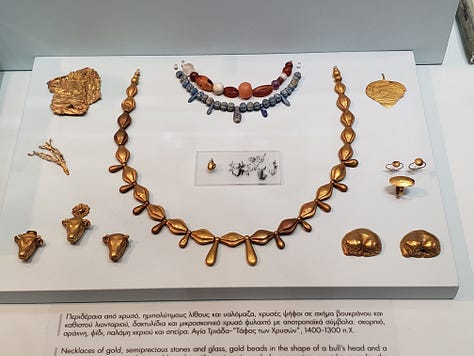
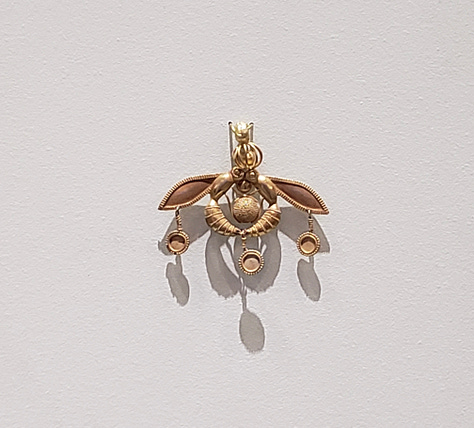
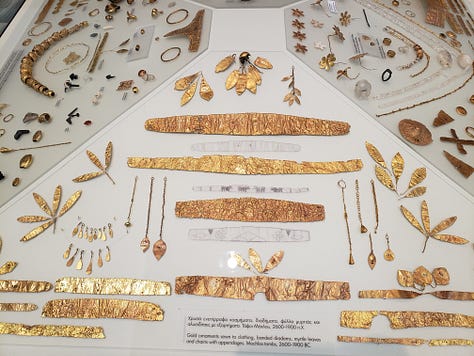
Now we spent quite a bit of time with the jewelry! From necklaces composed of gold papyrus and crocus flowers to semi-precious gemstone beaded necklaces of amethyst, carnelian, and lapis lazuli. This section of the museum is a literal treasure trove of golden jewels. We even saw the famous “Honeybee Pendant” aka the Malia Pendant which depicts two stylized bees joined head-to-head forming a symmetrical mirror image with circular pendants hanging from the tips of the wings, spread backward.
The pendant (thought to belong to a pin or necklace) was found in Malia, Crete at the ancient necropolis of Chrysolakkos in 1930. Interestingly, Chrysolakkos translates to “pit of gold.” While the insects have never been officially identified, honey and honey production was important to Minoan society, serving as a source of nutrition as well as a religious offering to the goddess Illithyia. A stop at the museum’s impressive gift shop and a ton of postcards later, we ended the day early to wake up early for our plans the next day.
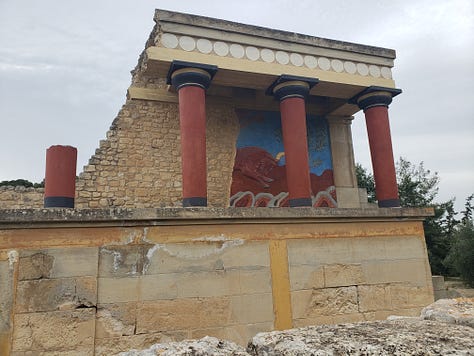
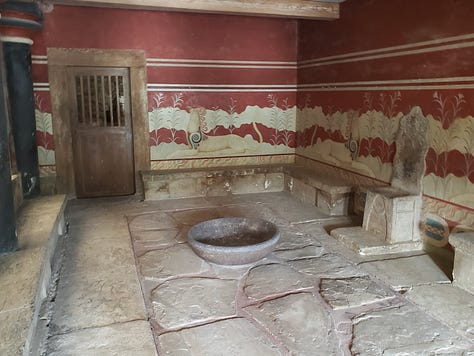
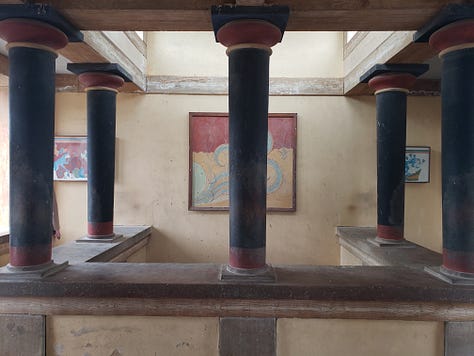
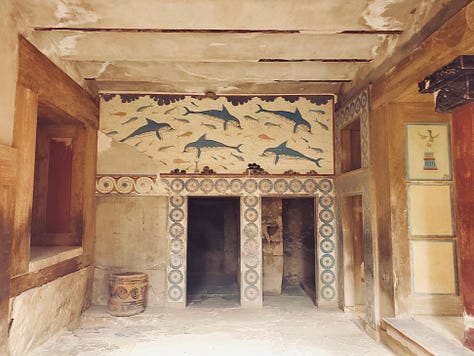
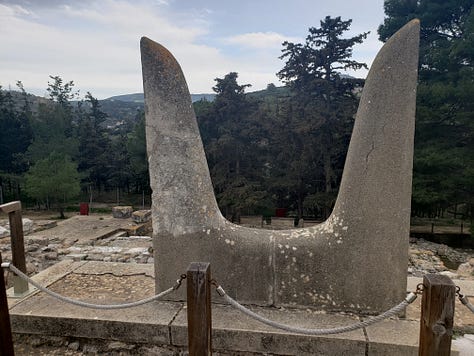
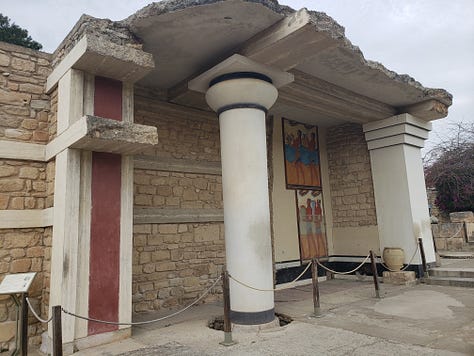
The Palace of Knossos
After getting distracted by some kitties on the road, we made our way to our second big destination: The Palace of Knossos. Knossos is an intricate palace complex suggested to be the mythical labyrinth of King Minos (from where the ‘Minoans’ get their name), and the home of the terrifying Minotaur in Greek mythology. Today, it is one of the most impressive archaeological sites in the Mediterranean. It was a gray, windy (very windy) day, and like the museum, we had the site largely to ourselves.
Some backstory on why the vibrantly-colored site currently looks this way. The site was first discovered and excavated by archaeologist Minos Kalokairinos in 1877, and in 1899, British archaeologist Arthur Evans undertook even more extensive excavations. This unearthed most of the palace and the many now-famous artifacts in the Heraklion Museum such as the Bull-Leaping Fresco, the snake goddess figurines, many coins (one even depicting a labyrinth!), and even the sanitation/water drainage system which included a water-flushing latrine system.
Despite many uncertainties in terms of reconstruction, colors, painting, and the layout of the architectural remains at the site, his work is largely responsible for bringing these Bronze Age civilizations to the forefront of scholarship at the time. However, the consensus among scholars is that the palace was never exactly as it appears today. All of this aside, it remains an impressive place to visit and should not be missed!
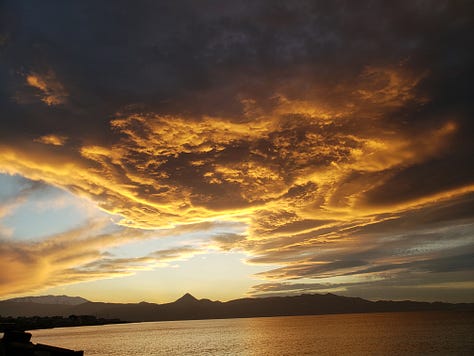
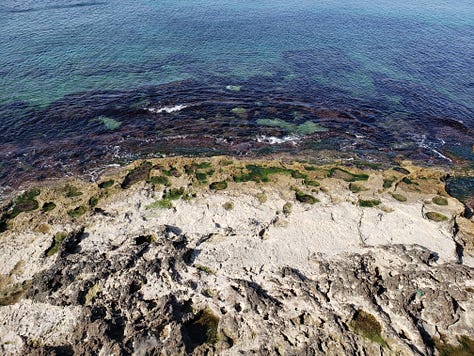
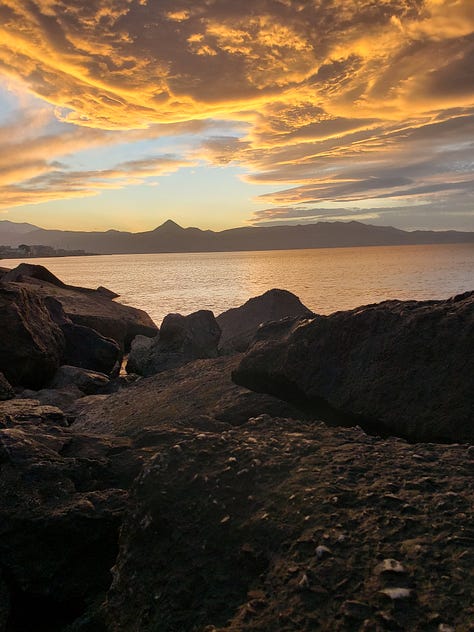
Homer’s “Wine Dark Sea”
Whenever someone describes the Aegean or the Mediterranean, as Homer’s “Wine Dark Sea,” I always hear someone comment on what is “Wine Dark” supposed to mean. Isn’t the ocean blue? Hasn’t it always been blue? Well, colors or the concept of colors, how they were thought of, and what they were called, were very different in antiquity. The ancients didn’t perceive color the way we do today. “Since dyes and pigments came only from natural sources, the range of available colorants in the ancient world was limited.”2
Additionally, words for colors in ancient languages didn’t necessarily just describe the hue of what they were referencing. Instead, they tended to describe them by referencing other qualities such as luster, brightness, or value. These are qualities that don’t align with our direct equivalents of color such as “blue” or “purple.” It should also be noted that translating these ancient texts does not give you 1:1 results. One word can mean a myriad of things. The goddess Aurora’s “saffron-colored robes” don’t just align with the actual color of her drapery but with the burning intensity of the early-morning sky.
Moreover, it’s possible Homer wasn’t referencing the color in his texts but instead its vastness and its unknown depths. It’s also equally possible he could’ve been referencing its appearance during a specific time of day when the sea looked inky.
Regardless, I couldn’t help but see it through the eyes of these ancient poets and authors as an unknown expanse filled with gods, nereids, whirlpools, and monsters. Here, the sunsets are a burning gold, and the darker colors along the waves seem to move against the current. The waves seemed to make high-pitched noises when they crashed along the rocky shores — a lot of it sounded like laughter. At that point, I knew my overactive imagination was getting the better of me. So we stayed and watched the skies burn gold along the shore before heading home to prepare for stop #2: Santorini.
If you enjoy my writing please consider subscribing to have By Odette delivered to your inbox. Subscriptions are free! But if you’d like to support my writing, I’ve added a “Buy Me a Coffee” tip jar button below. No pressure and thank you for reading!
Heraklion Archaeological Museum, “Statue Group of Isis-Persephone and Serapis-Hades.” Musuem catalog entry.
Tasha Vorderstrasse, quoted in, How did people use color in the ancient world?, University of Chicago, UChicago Magazine.





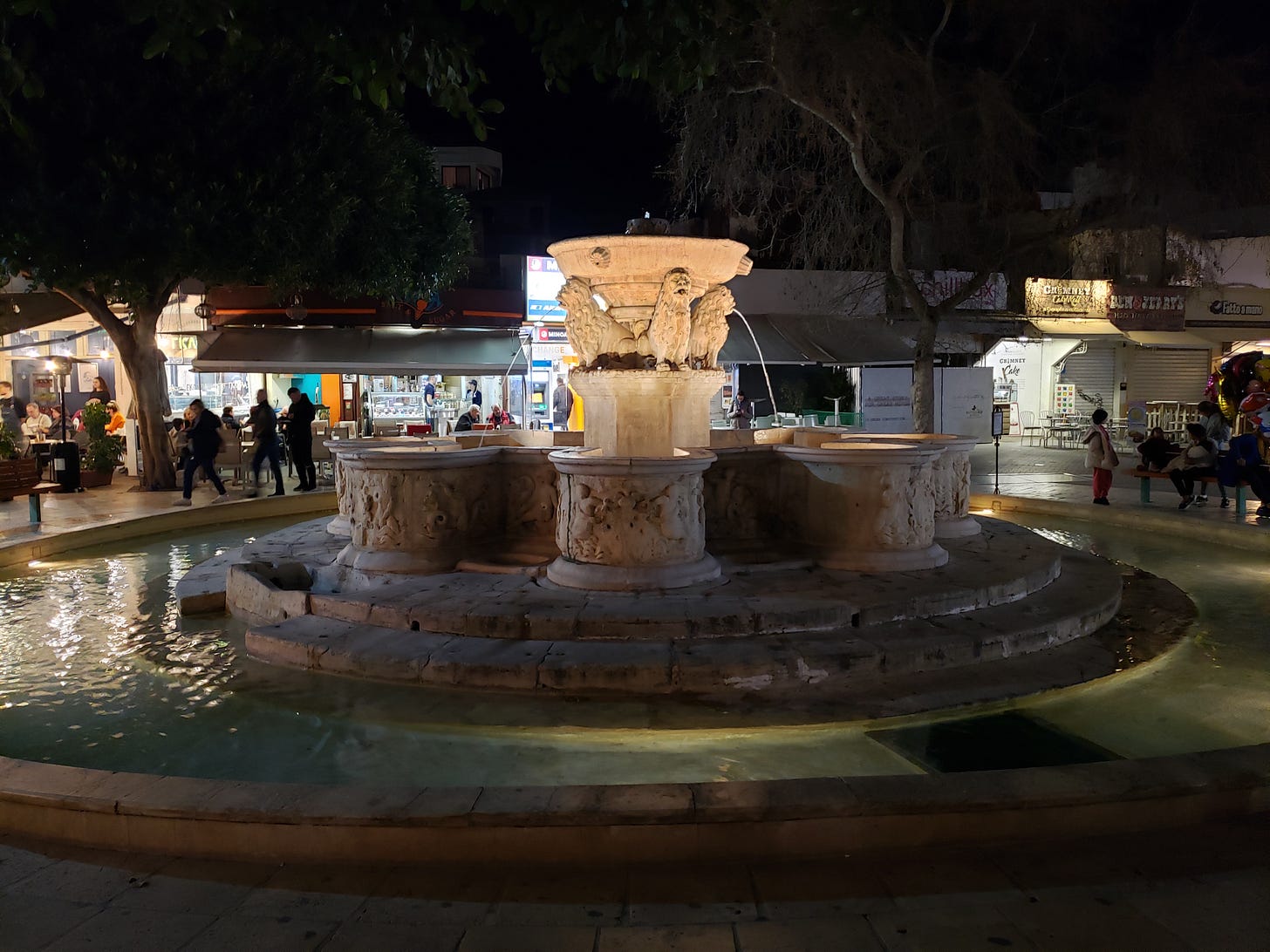
Wonderful travelogue! Thank you.
Thanks for detailing the marine motif pottery from Heraklion. Saw them for the first (and only)time in summer of 1976 and never forgot the beauty of the octopi curving around all those vessels. So gorgeous!
Lovely to know Crete still wows!